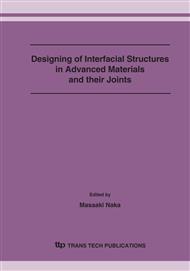p.245
p.251
p.259
p.265
p.271
p.277
p.283
p.289
p.295
Bonding Strength of W-Cu Joint by PECS Method
Abstract:
To make the tungsten and copper joint, several methods has been tried using the diffusion bonding system. When the thin plating Ni layer was used as the interlayer on tungsten surface, it bonded with copper under low bonding temperature and short holding duration by the pulse electric current sintering (PECS) machine. The effects of bonding temperature, bonding duration time, bonding pressure and the difference of specimen shape on the bonding strength were investigated. The tensile strength of joints depended on these factors. Highest strength attained to the copper tensile strength.
Info:
Periodical:
Pages:
271-276
Citation:
Online since:
September 2007
Authors:
Price:
Сopyright:
© 2007 Trans Tech Publications Ltd. All Rights Reserved
Share:
Citation:


